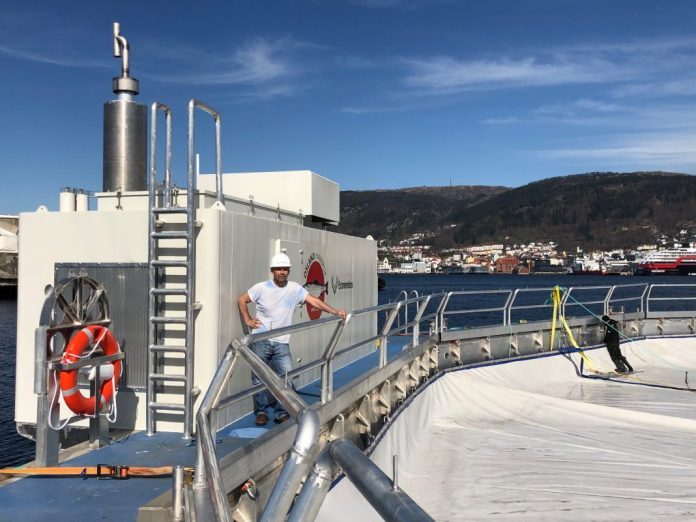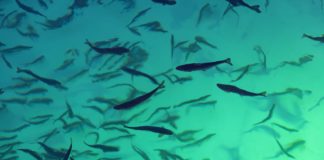Ecomerden promises less mortality and increased harvest weight.
“It’s t-shirt weather,” smiled Jan Erik Kyrkjebø against the bright sun.
On a scorching hot April day, the Ecomerden founder and his team are in full swing completing the company’s new 30,000 cubic m3 semi-closed cage.
“It has a total buoyancy of about 400 tonnes and throughput with circulated water at six m³ per second. For logistical purposes, it is built according to the module principle, ie with 12 welded pontoons. It constitutes the float collar,” he explained.
“And then we can expand to 16 pontoons, then we get twice the volume – and can produce twice as much fish,” added Kyrkjebø.
Post smolt and harvest size fish
The Ecomerden is located on the second floor of a brick building in the yard area of Bergen, Norway. Two half-finished yachts are piled up at the quay where the cage is moored. On the other side of the Damsgårdssundet, there are two Hurtigruten cruiseships laid up. Inside the dry dock of old BMV Laksevåg shipyard stands the city’s pride, the wooden sailship “Statsråd Lehmkuhl”.
The new cage is designed for 1,000 tonnes of biomass. Post smolt and harvest size fish.
“Instead of going directly from smolt plant to open cages, it goes to closed cages. And then the idea is that it will go into the open cage when it reaches a kilo. Then experience shows that you get a more robust fish, with less mortality and more harvest weight,” says Kyrkjebø to SalmonBusiness.
“It is planned to be towed over the weekend – to Osland. It will be located between Bjordal and Oppedal, at a site called Sørevik, in the Sognefjord.”
Six independent water inlets
“It is certified to an H/S of 2.5 meters, two knots current and peak period (distance between wave peaks – ed. Note) of 5.4 meters,” he said.
He added that the cage can be split when sorting fish, for example when transferring fish.
“Fish welfare is secured with six independent water inlets from about 30m deep to circulate it in the cage. At the same time, we can control the flow rate of the fish inside the cage. It is important for the growth and fitness of the fish – to make it more robust. Experience shows a very small mortality rate, more robust fish, and thus breeds significantly higher slaughter weight,” he added.

Automatic
“The float collar is made of extruded aluminium profiles. The cage is equipped with a machine room containing an emergency unit. If a power failure occurs, emergency power is automatically switched on from a diesel generator. In addition, the cage can be equipped with a manual start of all pumps located outside the engine room in case of fire in the engine room.”
Increased density, at a high average weight on the fish, is compensated by adding oxygen to the water.
“Automatic oxygenation occurs in relation to the oxygen levels we believe are correct in the cage. Large biomass needs to add oxygen in addition to the flow method,” he added.
Read also: Closed cage producer attracts international interest











